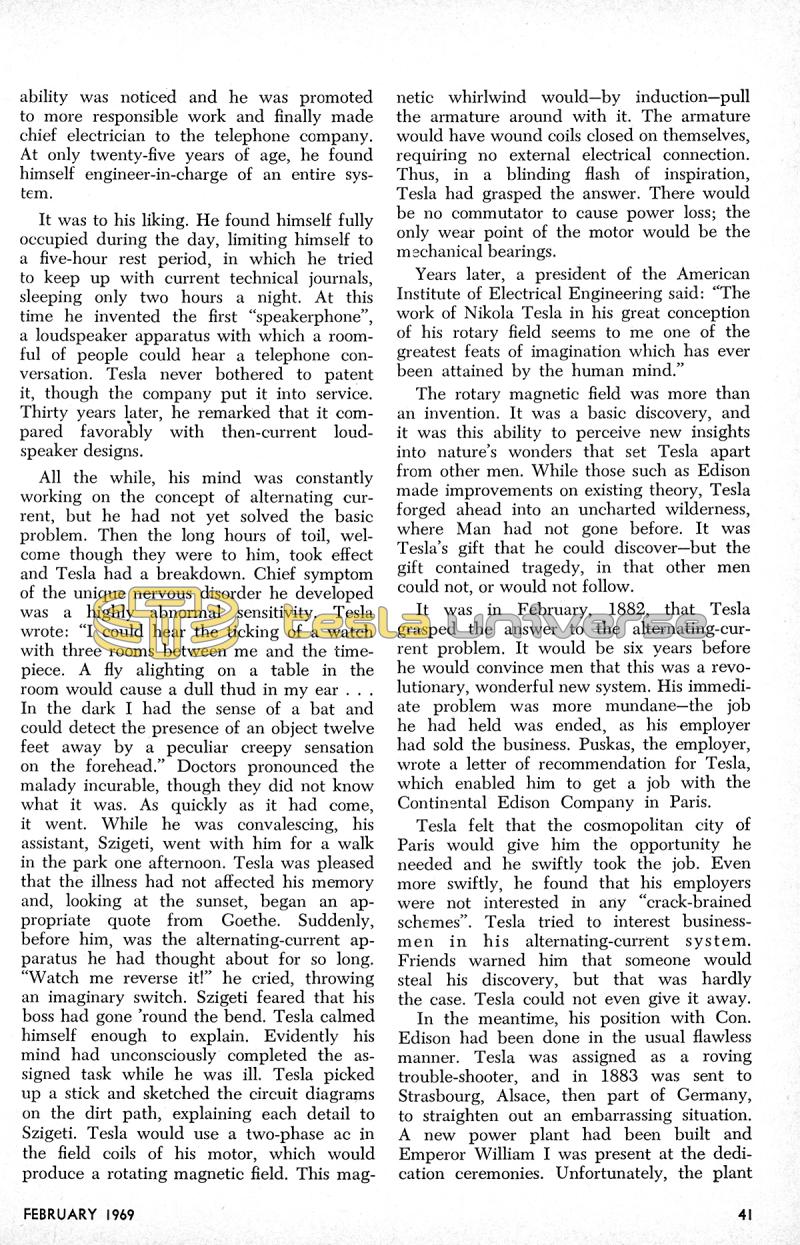
Nikola Tesla Articles
ability was noticed and he was promoted to more responsible work and finally made chief electrician to the telephone company. At only twenty-five years of age, he found himself engineer-in-charge of an entire system.
It was to his liking. He found himself fully occupied during the day, limiting himself to a five-hour rest period, in which he tried to keep up with current technical journals, sleeping only two hours a night. At this time he invented the first "speakerphone", a loudspeaker apparatus with which a roomful of people could hear a telephone conversation. Tesla never bothered to patent it, though the company put it into service. Thirty years later, he remarked that it compared favorably with then-current loudspeaker designs.
All the while, his mind was constantly working on the concept of alternating current, but he had not yet solved the basic problem. Then the long hours of toil, welcome though they were to him, took effect and Tesla had a breakdown. Chief symptom of the unique nervous disorder he developed was a highly abnormal sensitivity. Tesla wrote: "I could hear the ticking of a watch with three rooms between me and the timepiece. A fly alighting on a table in the room would cause a dull thud in my ear . . . In the dark I had the sense of a bat and could detect the presence of an object twelve feet away by a peculiar creepy sensation on the forehead." Doctors pronounced the malady incurable, though they did not know what it was. As quickly as it had come, it went. While he was convalescing, his assistant, Szigeti, went with him for a walk in the park one afternoon. Tesla was pleased that the illness had not affected his memory and, looking at the sunset, began an appropriate quote from Goethe. Suddenly, before him, was the alternating-current apparatus he had thought about for so long. "Watch me reverse it!" he cried, throwing an imaginary switch. Szigeti feared that his boss had gone 'round the bend. Tesla calmed himself enough to explain. Evidently his mind had unconsciously completed the assigned task while he was ill. Tesla picked up a stick and sketched the circuit diagrams on the dirt path, explaining each detail to Szigeti. Tesla would use a two-phase ac in the field coils of his motor, which would produce a rotating magnetic field. This magnetic whirlwind would-by induction-pull the armature around with it. The armature would have wound coils closed on themselves, requiring no external electrical connection. Thus, in a blinding flash of inspiration, Tesla had grasped the answer. There would be no commutator to cause power loss; the only wear point of the motor would be the mechanical bearings.
Years later, a president of the American Institute of Electrical Engineering said: "The work of Nikola Tesla in his great conception of his rotary field seems to me one of the greatest feats of imagination which has ever been attained by the human mind."
The rotary magnetic field was more than an invention. It was a basic discovery, and it was this ability to perceive new insights into nature's wonders that set Tesla apart from other men. While those such as Edison made improvements on existing theory, Tesla forged ahead into an uncharted wilderness, where Man had not gone before. It was Tesla's gift that he could discover-but the gift contained tragedy, in that other men could not, or would not follow.
It was in February, 1882, that Tesla grasped the answer to the alternating-current problem. It would be six years before he would convince men that this was a revolutionary, wonderful new system. His immediate problem was more mundane-the job he had held was ended, as his employer had sold the business. Puskas, the employer, wrote a letter of recommendation for Tesla, which enabled him to get a job with the Continental Edison Company in Paris.
Tesla felt that the cosmopolitan city of Paris would give him the opportunity he needed and he swiftly took the job. Even more swiftly, he found that his employers were not interested in any "crack-brained schemes". Tesla tried to interest businessmen in his alternating-current system. Friends warned him that someone would steal his discovery, but that was hardly the case. Tesla could not even give it away.
In the meantime, his position with Con. Edison had been done in the usual flawless manner. Tesla was assigned as a roving trouble-shooter, and in 1883 was sent to Strasbourg, Alsace, then part of Germany, to straighten out an embarrassing situation. A new power plant had been built and Emperor William I was present at the dedication ceremonies. Unfortunately, the plant
